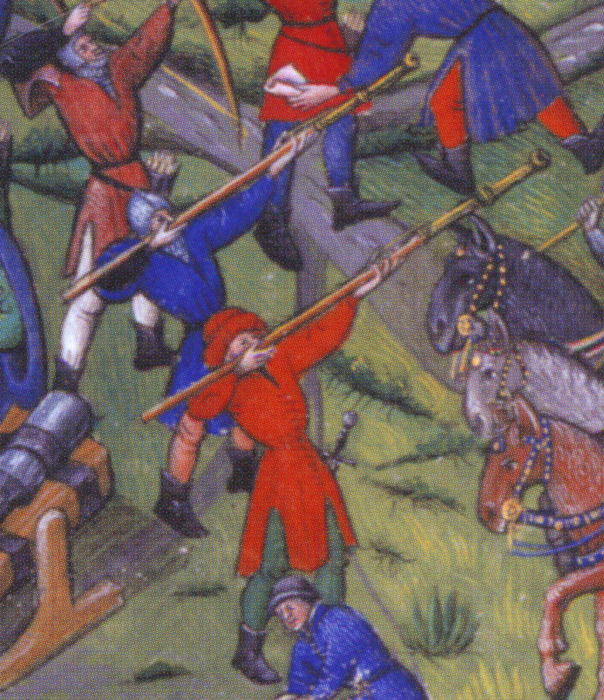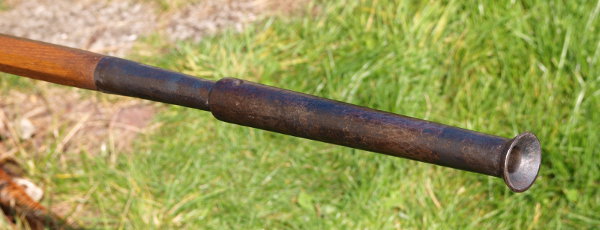
Siegfried Julius von Romocki aptly defined the term firearm in 1895 as: "… a tube from which projectiles are thrown by explosive force .…1)
In Central Europe, the first references to firearms and handguns appeared in the 1330s, and within a short time they had already changed the tactical and tactical nature of warfare. And most probably they were also responsible for the end of the classical knighthood.
The earliest written record dates back to 1326, when the city of Venice ordered iron bullets and barrels for city's defence on 11 February2) Another record also comes from Italy, when the city of Perugia procured about 500 handguns in 1364. Since then, written records of their acquisition and use have become more and more frequent. There are early references from Germany from Augsburg in 13723) and Nuremberg in 1388.4)
Firearms were initially made by blacksmiths and bronze casters who already had experience with the materials. The gun shafts were made by carpenters and later by specialised craftsmen. The rapidly developing technical knowledge and manufacturing methods led to a further specialisation of these professions. Depending on the regulations and craft codes of the individual towns, gunsmiths and gunsmiths belonged to the liberal arts, which were only later organised into guilds. For example, Nuremberg gunsmiths were only able to form their own guilds in the course of the 16th century.5) In Hamburg, armourers produced cannons and ammunition in the municipal gun house established in 1476, but so far we have no reliable evidence of other armourers from the 15th and 16th centuries.6)
The first mentions of firearms from the City of Hamburg come from the treasury accounts of 1372, when the city council spent "12½ ℔ 8 ß for twe donrebussen" (… for two thunder gonnes) and in 1373 "8 ℔ 8 ß vor twe kopperne bussen" (… for two gonnes of copper), without, however, noting whether they were handguns or cannons.7) The small numbers, the amount of money spent and the long procurement routes, however, speak in favour of larger guns.8) One year later, in 1374, the city council issued "24 ß Kusvelde vor bussen" (… to Kusvelde for guns) and "Craneken 3 ℳ vor pyle to bussenschote" (… to Craneken for lead for projectiles).9) Handguns, on the other hand, are first explicitly mentioned in Hamburg documents in the Thomae-Apostoli Bursprake (citie's council order) of 1486 and the Petri Bursprake of the following year 1487. In these, the city council ordered that "... young brewers with their own inheritance, as well as officials with [?] should at least a shield, helmet, an crossbow and a bunch of quarrels, or a hand gun together with equipment / accessories for it".10)
„De jungen bruwere, de nene egen erue hebben, vnnde eyn iewelik amptman, de sines sulues is, schal to dem(e) mynsten yo heb ben schilt, hod, armborst vnnde eyn (eyene)halffhundert verdiges schotes effte ene handbussen myt resschup dar to horende edder alßo bauen geschreuen is." 10)
There are no surviving handguns from Hamburg itself and only a few from the rest of northern Germany from this period, for which reason we have to turn to rifles from other regions that fit the period.
Handgonne „Agnes”

Our handgonne is a reconstruction based on the so-called Hussite Tabor rifle. The Tabor rifle was found in 1892 during construction work on Ring Square in the South Bohemian town of Tabor (Czech Republic) and is now kept in the Husitské Muzeum there. The piece is a wrought iron barrel with a weight of approx. 2,900 g and a total length of 420 mm. The length of the bore is 250 mm with a calibre of 20 mm at the muzzle. The original wooden stock was no longer preserved.11)

Our reconstruction has a barrel length of 410 mm and a soul length of 270 mm with a calibre of 18 mm. The total length of the rifle is 192 cm with the oak wood handle. The total weight is 2,200 g. In contrast to the historical original, our rifle has a funnel-shaped muzzle. The rifle takes a maximum permissible charge of 20 g of blackpowder. We named it after the patron saint of Bohemia, the monastery founder and Princess Agnes of Bohemia (1211–1282), because of its location in Tabor..
Wrought Iron Gun with Beam Shaft
This is a freely interpreted model of a small hooked gonne with a barrel made of iron and a slender beam stock. The hook is welded to the lower barrel of the rifle and protrudes through an opening in the stock.

The rifle model has a barrel length of 300 mm and a soul length of 285 mm with a calibre of 18 mm, and a service load of 20 g. The overall length of the rifle is 118 cm with the beam stock made of ash wood. It has a total weight of 2,800 g.
Hackbut
Hooked gun modelled on various armouries from the Maximilian period, similar to the MZ13 hooked rifle from Pilsen, Czech Republic12), or originals at Veste Oberhaus in Passau or Veste Lüdinghausen, both in Germany.

It has an iron barrel with a welded hook and grommet with an oak stock. The touch hole is on the top right of the barrel. The rifle has a barrel length of 640 mm and a bore length of 475 mm with a calibre of 25 mm. The overall length of the rifle is 134 cm with a total weight of 5,700 g with a load of 40 g of black powder.
Tactical Utility
 The great tactical advantages of the early firearms lay initially in their psychological effect on the enemy. The main disadvantages were their initially low precision and relatively low rate of fire compared to bows and crossbows. However, shooting tests with replica rifles confirmed that they could develop considerable penetrating power and that skilled archers could achieve acceptable hit accuracies. Their lack of precision could be put into perspective by the historical way of fighting, where they were predominantly fired at mass targets, larger and densely packed army clusters, which significantly increased the hit probability of the individual shots..11) Numerous authors cite the lower manufacturing costs of firearms compared to those of crossbows as well as easier training of riflemen compared to archers and crossbowmen. The rapid spread of this new weapon system suggests that its tactical advantages were valued much more highly than its disadvantages.13)
The great tactical advantages of the early firearms lay initially in their psychological effect on the enemy. The main disadvantages were their initially low precision and relatively low rate of fire compared to bows and crossbows. However, shooting tests with replica rifles confirmed that they could develop considerable penetrating power and that skilled archers could achieve acceptable hit accuracies. Their lack of precision could be put into perspective by the historical way of fighting, where they were predominantly fired at mass targets, larger and densely packed army clusters, which significantly increased the hit probability of the individual shots..11) Numerous authors cite the lower manufacturing costs of firearms compared to those of crossbows as well as easier training of riflemen compared to archers and crossbowmen. The rapid spread of this new weapon system suggests that its tactical advantages were valued much more highly than its disadvantages.13)
References
- Sixl (1897/89): Bd. 1, Heft 5, S. 15 (quotes S. J. v. Romoczki: Geschichte der Sprengstoffchemie)
- Davis (1941): p. 39
- Kramer (1995): p. 92
- Boeheim (1890): p. 445
- Willers (1973): pp. 71-111
- Fiedler (1974): pp. 100-122
- Kämmereirechnungen der Stadt Hamburg: 1350-1400, p. 18318
- Fiedler (1974): pp. 100-101
- Kämmereirechnungen der Stadt Hamburg: 1350-1400, p. 20230
- Bolland (1960): 83.6 und 84.25
- Sixl (1897/89): Vol. 2, p. 413-417
- Frýda (1988)
- Wlassaty (1977)
Currency icons: ℔ talentum (Pfund / Pound) / ℳ marka (Mark) / ß solidus (Schilling)
Text and photos: Andreas Franzkowiak
